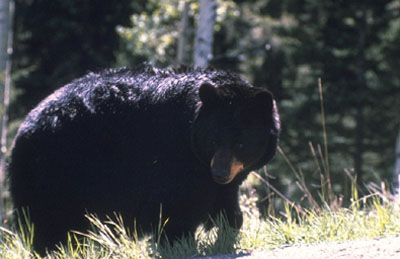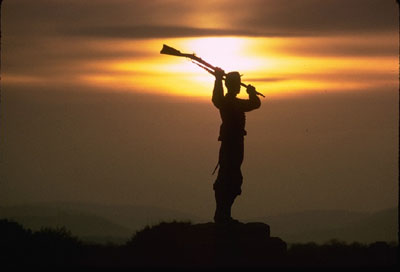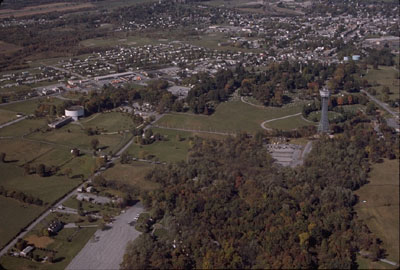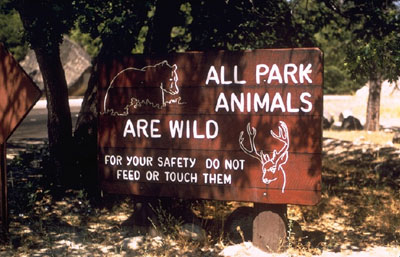
Centennial plan to provide aid to parks
In the year 2016, the national park system will celebrate its 100th anniversary
With that special date in mind, President Bush has asked Congress to implement a $3 billion proposal to upgrade the condition of all national parks spanning over nine years entitled the “Centennial Initiative.”
Approximately $100 million will be spent each year on the project from private and public investments, with Bush wanting congress to guarantee that it will match the amount in donations bringing it to a possible $200 million spent each year.
 |
A bear walks in Yellowstone National Park (Photo courtesy of the National Park Service). |
Despite cutting the funding by five percent in the budget for fiscal year 2007, the National Park Service budget for fiscal year 2008, which begins Oct. 1, is the largest increase in park operations funding ever proposed.
“There are budgeting priorities within the administration and the national park system was not very high for the last several years,” said National Park Service spokesman Jeffrey Olson. “Nonetheless, we are pretty excited about the president’s proposed budget for fiscal year 2008 because it is significant with a lot of different ideas.”
Originally, the proposal was announced by Bush in August 2006 on the 90th anniversary of the park system. If the proposal is signed into law, Olson says the first step of spending the money will include the addition of 3,000 seasonal employees like park rangers as well as an increase in maintenance staff which many of the parks have expressed an interest in having.
“The private commitments will also play a key role in the process, visitors can give money in a jar when they visit a park and even join a friend’s group of a particular park,” Olson said. “They can also give to the National Park Foundation which is a private non-profit organization that aids the national park system.”
Other projects include landscaping, increasing volunteers in park programs and 40 V.I.P coordinators in parks that do not have them yet. They would be responsible for recruiting and training volunteers at the parks.
Both branches of congress are likely to pass the bill with Senate Majority Leader Harry Reid (D-NV) and Speaker of the House of Representatives Nancy Pelosi (D-CA) signing a letter urging for more park legislation. Olson expects congress to take a closer look at the issue by the fall.
Every national park will get a benefit from the initiative and the money will be spent accordingly depending on what each park requires for upgrades. Olson also added that the money for the proposal will have to be approved each year as the initiative is part of the annual appropriations for each fiscal year beginning on Oct. 1.
 |
A statue honoring soldiers who died at the Battle of Gettysburg at Gettysburg National Military Park (Photo courtesy of the National Park Service). |
One such park desperate for additional dollars is the historic Civil War battlefield park at Gettysburg.
“Gettysburg National Military Park needs more funding for more interpretive rangers and a lot more maintenance,” Gettysburg park public affairs specialist Katie Lawhon said. “Right now, there are 180 projects we have to maintain and, with this budget proposal, we can move forward instead of staying put.”
In addition, Gettysburg is also suffering from deteriorating historical artifacts including barns and homes that are used in the re-enactments of the battle itself. Also in 2006, 80,000 of the park’s two million visitors did not get to experience a ranger-led interpretive program and many school groups were denied ranger-led park tours because of the lack of funds.
Lawhon believes that will change with the proposed budget request at $1.1 million, which is a 20 percent increase from the previous year for Gettysburg with further plans to renovate its museum and build a better visitor’s center. This according to Lawhon will allow the visitor to experience Gettysburg in a whole different light with more efficient technology and interactive experiences.
With 150 historic structures, 1,300 monuments, 400 cannons and 6,000 acres altogether, it is no surprise that Gettysburg park officials are optimistic about the possibilities.
“Gettysburg is definitely in a good position to take on these challenges,” Lawhon said. “I think what makes Gettysburg so unique is how people identify with it from a historical perspective.”
Even though the initiative has support from many individuals, some have doubts and do not put much stock into the proposal. This includes U.S. Rep. Nick Rahall (D-WV), who has expressed doubts about the Bush Administration following through on its promises.
| An aerial view of the city of Gettysburg and Gettysburg National Military Park (Photo courtesy of the National Park Service). |  |
“He (Rahall) has publicly questioned the initiative and we support him because they (Bush Administration) also said there would be more money for the land and water conservation fund,” National Recreation and Preservation Sub-Committee Staff Director Rick Healy said. “”We support the newfound enthusiasm for the proposal, however we just want to make sure that it is carried out properly.”
Aside from the many benefits that the initiative offers for the many visitors of national parks, it will also improve the quality of wildlife that the parks have. For example, various national parks are home to grizzly bears, brown bears, elk, and other types of animals.
“In Yellowstone, vegetation is growing back and that is because of the decrease in elk population,” Olson said. “That said with the extra money coming in they are trying to determine whether or not they should reintroduce wolves back into Yellowstone to further control the elk population.”
Another large park that is sure to see a lot of the money is Yosemite National Park in Northern California. The estimated amount of money that will be brought to upgrade the facilities is estimated at $1.3 million.
“It (Yosemite) has an aging infrastructure and hopefully this initiative will do everything for the park,” Yosemite public affairs specialist Scott Gediman stated. “We want these changes to Yosemite to benefit the visitor with protecting the campsites and trails for example.”
There is also some discussion about whether there will be new national parks established with the amount of money being raised. However Olsen said he doesn’t see that happening anytime soon.
“I am sure the public would love to see more national parks, but some places don’t really have the necessary acreage to be a national park,” Olson said.
| A sign reminds visitors not to feed or touch animals at Yosemite National Park (Photo courtesy of the National Park Service). |  |
Olson sees that beyond 2016 that there will be a vibrant system of national parks, assuming that everything goes according to plan.
“It is a great time for the National Park Service as many people want careers in it. So right now we are trying to contemplate what will happen in the future,” Olson said.
Overall, many parks experts expect the length of time of 10 years, however they say that is a rough estimate and it all depends how the money is distributed among the various parks.
Gediman also believes that there is still a long way to go but the way he sees it is summed up by something he heard as a child that still resonates with him today.
“Someone once said that the national park system was America’s best idea and one of the best things we currently have,” Gediman said. “It is our job to take care of them.”

Comments are Closed